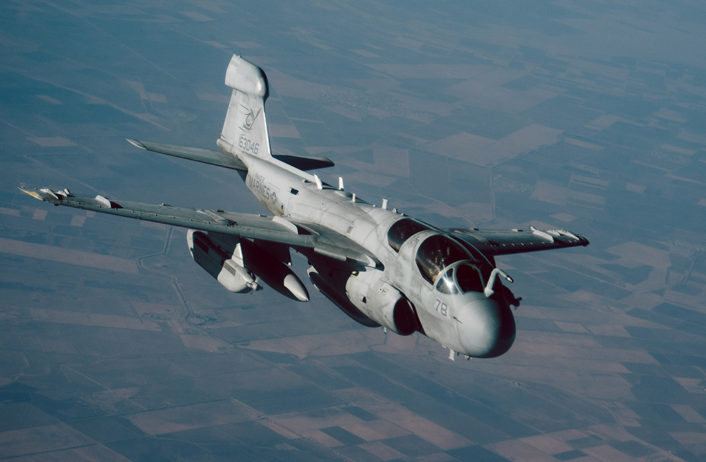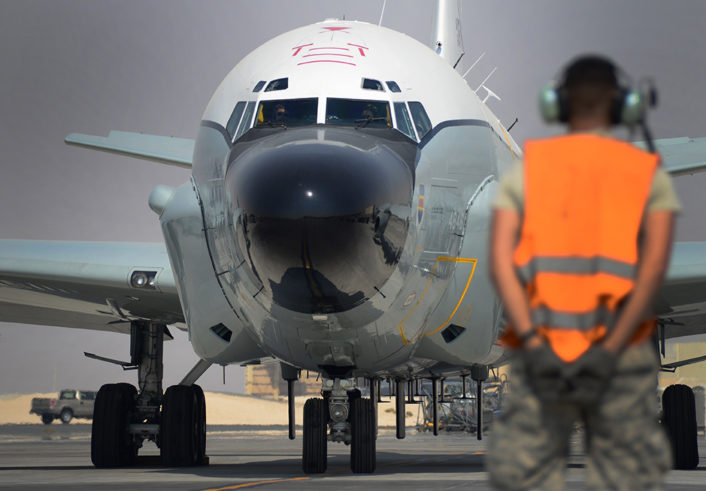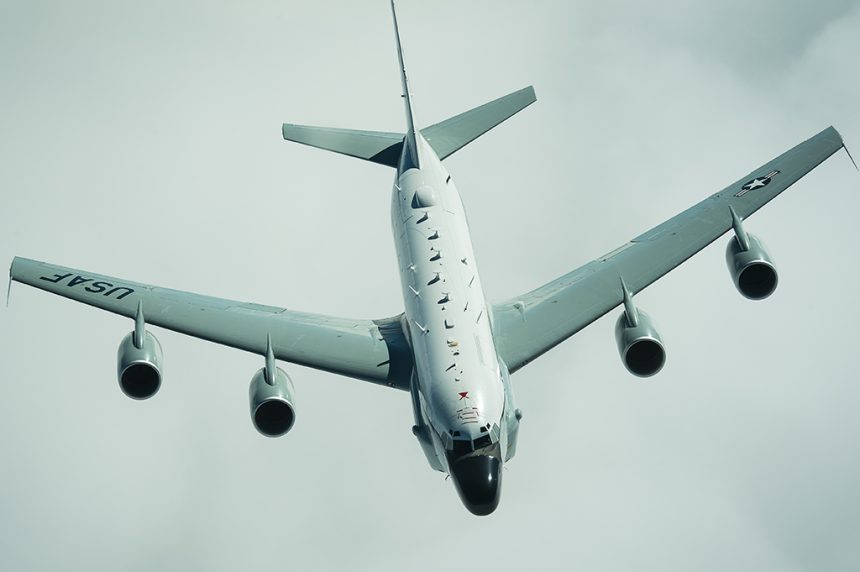In the skies over Iraq, USAF spyplanes, USMC and USN Electronic Attack aircraft work together to deny the Islamic State the ability to communicate.
The image above shows a U.S. Air Force RC-135V/W Rivet Joint, deployed to Al Udeid, Qatar, disconnecting from a USAF KC-10 Extender tanker after receiving fuel near Iraq on Dec. 5, 2016.
Here below you can see a similar photograph of a U.S. Marine Corps EA-6B Prowler electronic attack aircraft belonging to VMAQ-2 from MCAS Cherry Point, temporarily deployed to Incirilik Air Base, Turkey preparing for refueling from a 340th Expeditionary Air Refueling Squadron KC-135 Stratotanker over Iraq, on Nov. 29, 2016.
Although they have a different role and belong to different services both aircraft are often part of the same team, a team whose goal is to shut down Daesh communications.

Little details are available about the missions these HVAs (High Value Assets) carry out together in theater against the Islamic State even though we have been able to collect some interesting details about the way they team up to conduct their secretive tasks.
First of all, a major role is played by the RC-135 Rivet Joint intelligence gathering planes.
In fact, as already pointed out by War Is Boring journalist Joseph Trevithick, not only do the USAF Rivet Joints eavesdrop and pinpoint “enemy” radio signals, but they can also disseminate the details about these targets via tactical data-link to other aircraft, including the Prowlers, whose role is to jam those frequencies in order to prevent terrorists from talking one another on the radio or cell phone or using portable transmitters to trigger IEDs (Improvised Explosive Devices).
Robert Hopkins, III, a former RC-135 aircraft commander who flew the S, U, V, W, and X models in the 1980s and 1990s, and author of a book on the type, says that “RJ (Rivet Joint) can share the intelligence they collect with a wide variety of assets, both aerial and ground, to meet their operational requirements.”
Here are some relevant excerpts from his revised book Boeing KC-135: More Than a Tanker to be released by Crécy in February 2017, that explain how this ability to collect and share information with other aircraft has evolved during the years:
“Among the significant improvements included in the Baseline 7 jets (beginning with 62-4131 in late 2001) were derivatives of the Link 16 Joint Tactical Information Display System (JTIDS), including Tactical Digital Links (TDL), formerly Tactical Digital Information Links (TADIL). These provided narrowband communications with other tactical airborne assets as well as the Combined Air Operations Center (CAOC), emphasizing the Rivet Joint’s increasing conventional combat support role. […]
The impressive capabilities of the Rivet Joint in operations in Bosnia, Afghanistan, Iraq, and elsewhere found strong support among combat commands, and led to a broad range of planned enhancements. […]
Baseline 8 jets incorporated improved collection techniques, ‘user friendliness’, and system reliability, as well as automated and faster information dissemination capabilities. They were the first to be extensively ‘connected’ to other airborne and ground-based intelligence, surveillance, and reconnaissance (ISR) and targeting assets. RC-135W 62-4126 was the first Baseline 8 Rivet Joint. It included the satellite-based Remote Extended Aircraft Position Enabling Reachback (REAPER—also noted as Narrowband Reachback, or NABRE) and Network Centric Collaborative Targeting (NCCT) systems.
[…]
Baseline 8 is also able to ‘talk’ to the U-2S and the ground-based, tri-service Distributed Common Ground System (DCGS) processing and dissemination architecture to connect directly with other ISR airplanes such as the Beechcraft RC-12 Guardrail, Boeing E-8 JointSTARs, and US and allied nation Boeing E-3 AWACS.
[…]
A single Rivet Joint, for example, might detect a signal of interest (SOI) but be unable to provide a precise location, especially as the RC-135 moves along its flight path. Using multiple, networked NCCT platforms, however, means that a Rivet Joint, a Guardrail, and a U-2S would all detect the same SOI, and, within seconds, triangulate its precise location and relay that to the CAOC and national targeting agencies.
[…]
Among the latest upgrades to the Rivet Joint fleet is the FAB-T, a ‘second-generation terminal’ system capable of passing low-rate data between air and ground assets. […] First tested in 2011 on NC-135W 61-2666, the FAB-T allowed the rivet joint to connect with a MILSTAR satellite and then transmit data and voice communication with a ground facility. Since then, the data transmission rate has increased, allowing a ‘more secure communication capability to deliver much higher quantities of actionable intelligence products into the hands of the warfighter.’”

Islamic State fighters rely heavily on commercial radios and cell phones; they use Internet and send emails from their mobile devices, and aircraft from the various services continuously work to intercept all these signals and, if needed, make such communication impossible (by disturbing the comms or attacking the cell towers).
And, sometimes, based on data collected and disseminated by Rivet Joints, “kinetic Electronic Attack platforms” are called in to target high value individuals, preventing them from dispatching orders to other militants. By jamming their cell phones with high-power signals or the old way: by dropping actual ordnance on them (a role that can be fullfilled not only by mission-purpose aircraft or an F-16CJ “Wild Weasel” but also by a more “conventional” bomber.)
As probably done last year by a VAQ-137 Boeing EA-18G Growler, the Electronic Warfare variant of the two-seat F/A-18F Super Hornet (that replaced the EA-6B Prowlers in U.S. Navy service), embarked on USS Theodore Roosevelt supporting OIR that sported the unequivocal High Value Individual cell phone-jamming kill mark.
By the way, VMAQ-2 “Playboys” are currently involved in a 6-month tour of duty started in October, when the unit replaced another Marine Corps squadron, the VMAQ-4 “Seahawks” (that were spotted at Lajes airfield, Portugal, showing some interesting mission markings and insignia on their way back to the U.S.)
Related articles
















